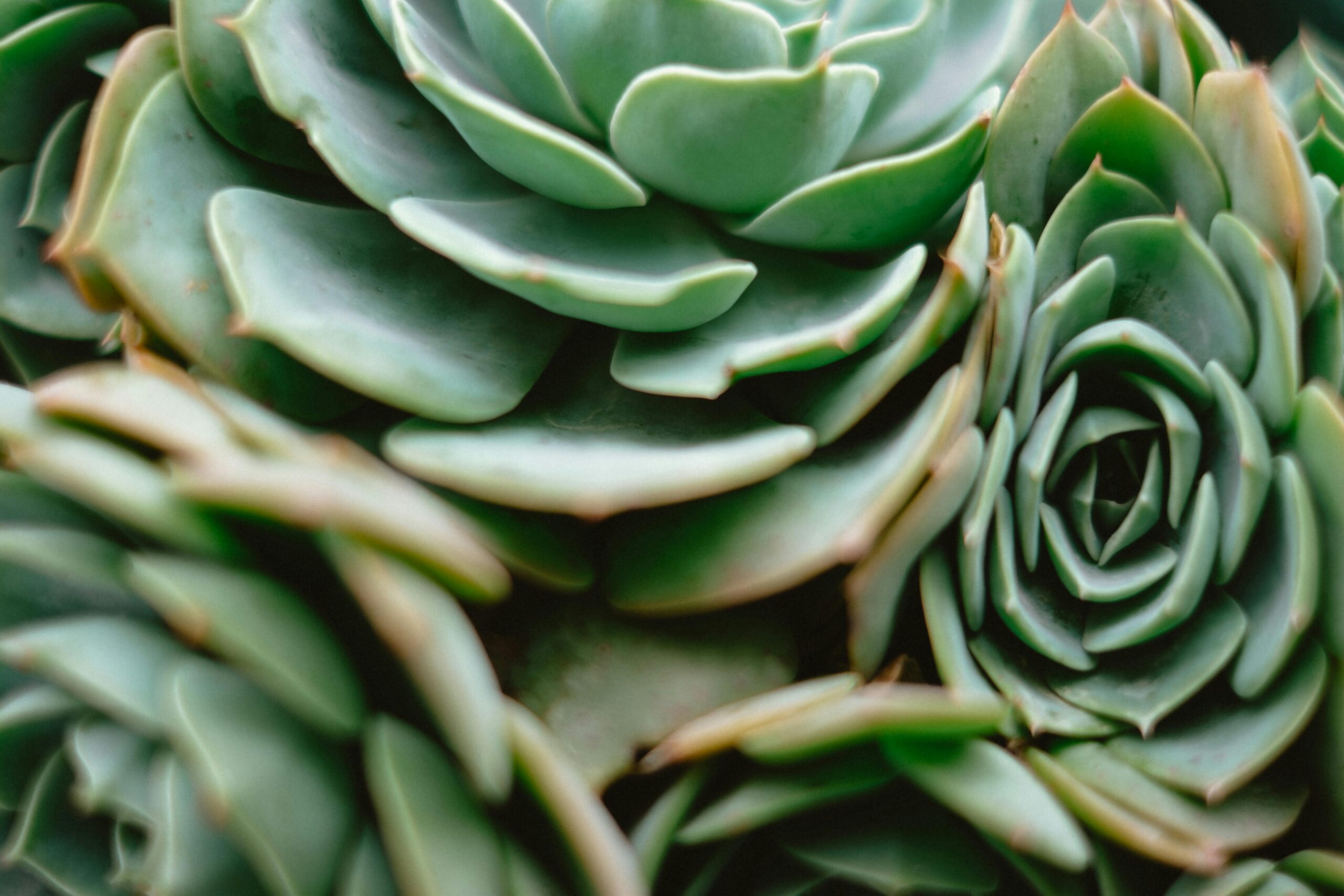
1. Botanical Overview of Echeveria:

- Family and Species:
- Echeveria is part of the Crassulaceae family, which includes other popular succulents like jade plants (Crassula).
- The genus contains over 180 species, many of which are hybridized for ornamental purposes.
- Plant Characteristics:
- Typically forms rosettes of thick, fleshy leaves that are often waxy or frosty in appearance.
- Colors can range from green to blue, purple, red, and even pink, depending on the variety and growing conditions.
- Flowers are usually tubular and come in shades of orange, pink, or yellow, often appearing in clusters.
2. Ideal Growing Conditions for Echeveria:
- Light:
- Prefers bright, direct sunlight, ideally 6 hours a day.
- Can tolerate some light shade, but prolonged periods of low light will result in leggy growth and loss of color.
- Best placed on a south or west-facing windowsill for optimal light.
- Temperature:
- Thrives in warm conditions, with ideal temperatures between 60°F–85°F (15°C–29°C).
- Protect from frost and cold drafts, as they are sensitive to temperatures below 50°F (10°C).
- Humidity:
- Prefers dry air and is well-suited for average indoor humidity.
- Avoid placing near humidifiers or in overly damp environments, as excess moisture can lead to root rot.
- Soil:
- Requires well-draining soil, such as cactus or succulent mix.
- Consider adding perlite or sand to your potting mix to ensure drainage and prevent water retention.
- A slightly acidic to neutral pH (around 6.0–7.0) is ideal.
3. Watering Echeveria:
- Watering Basics:
- Water thoroughly when the soil is completely dry, typically every 7-10 days during the growing season (spring and summer).
- In winter, reduce watering frequency as the plant enters a dormant phase and requires less moisture.
- Water at the base of the plant, avoiding wetting the leaves to prevent rot.
- Signs of Overwatering:
- Yellowing, mushy, or translucent leaves, often accompanied by a foul smell from the soil (root rot).
- Wilting despite wet soil can indicate overwatering.
- Signs of Underwatering:
- Wrinkling or shriveling of the leaves, which indicates the plant is dehydrated.
- Dry, brittle leaves that snap easily can also be a sign of underwatering.
- Watering Tips:
- Allow water to drain completely from the pot to avoid waterlogging.
- Use room-temperature water and consider watering less frequently in cooler months.
4. Fertilizing Echeveria:
- When to Fertilize:
- Fertilize during the growing season (spring and summer) every 4-6 weeks.
- Do not fertilize during the dormant period (fall and winter) when the plant is not actively growing.
- Type of Fertilizer:
- Use a balanced, diluted liquid fertilizer designed for succulents and cacti (typically with a 10-10-10 or 14-14-14 NPK ratio).
- Alternatively, use a slow-release granular fertilizer specifically formulated for succulents.
- How to Fertilize:
- Apply fertilizer directly to the soil after watering, to avoid burning the roots.
- Always dilute the fertilizer to about one-quarter strength to prevent over-fertilization.
- Signs of Over-Fertilizing:
- Yellowing or browning leaf tips, excessive leggy growth, or salt buildup around the base of the plant.
- Signs of Under-Fertilizing:
- Slow growth or lack of vibrant color. The plant may appear stunted or lack the typical rosette shape.
5. Common Issues and How to Solve Them:
- Etiolated Growth (Stretching):
- Causes: Lack of light, especially if the plant is not getting enough direct sunlight.
- Solutions: Move the plant to a brighter location with more direct sunlight to encourage compact growth.
- Yellowing or Drooping Leaves:
- Causes: Overwatering, underwatering, or nutrient deficiency.
- Solutions: Check watering routine, adjust as necessary, and ensure the plant is in well-draining soil. Consider fertilizing if the plant has not been fed for some time.
- Leggy Growth:
- Causes: Insufficient light, overcrowding, or improper watering.
- Solutions: Ensure adequate light and space for the plant to grow. Prune leggy stems to encourage more compact growth.
- Pests:
- Common pests: Mealybugs, aphids, scale insects, and spider mites.
- Solutions: Inspect regularly for pests, use a cotton swab dipped in rubbing alcohol to remove mealybugs, or apply insecticidal soap to affected areas.
6. Pruning and Maintenance:
- Why Prune Echeveria?
- Pruning helps maintain the plant’s shape and encourages fuller growth.
- It also removes dead or damaged leaves, preventing fungal infections and pests.
- When to Prune:
- Prune during the growing season (spring and summer) when the plant is actively growing.
- Remove any dead or dried leaves at the base of the rosette to keep the plant looking tidy.
- How to Prune:
- Use clean, sharp scissors or pruning shears to remove unwanted stems or leaves.
- If you are cutting back stems, ensure that the plant has a few healthy leaves remaining to continue growing.
- Maintaining the Rosette Shape:
- Echeveria naturally forms rosettes, so avoid cutting too much from the center. Instead, trim the outer leaves to maintain the shape.
7. Repotting Echeveria:
- When to Repot:
- Repot when the plant has outgrown its container (usually every 1-2 years) or when the soil has become compacted and no longer drains well.
- If the roots are crowded or growing out of the pot, it’s time to repot.
- Best Potting Tips:
- Choose a pot with drainage holes to avoid water retention.
- Use a well-draining succulent or cactus mix, or create your own mix with perlite, sand, and peat.
- Repotting Steps:
- Gently remove the plant from the pot, shaking off excess soil.
- Trim any damaged or rotting roots.
- Place the plant in a slightly larger pot with fresh, well-draining soil.
- Post-Repotting Care:
- Water sparingly for the first few days after repotting to avoid root rot while the plant settles in.
8. Propagation of Echeveria:
- How to Propagate:
- Echeveria can be propagated through leaf cuttings, offsets, or seeds.
- The most common method is leaf cuttings: gently twist off a healthy leaf, let it callous for 1-2 days, and then plant it in dry, well-draining soil.
- Propagation Tips:
- Ensure the cutting is healthy and free of any pests or diseases.
- Use a shallow container to allow the roots to develop without being submerged in water.
- Speed of Propagation:
- Leaf cuttings typically take a few weeks to root, while offsets can be separated and repotted when they are large enough (often a few months).
9. Benefits of Owning Echeveria:
- Aesthetic Appeal:
- Known for their striking rosettes and vibrant colors, Echeveria is perfect for adding visual interest to any space.
- Low Maintenance:
- Echeveria is a relatively low-maintenance plant, making it a great option for beginners or those with busy schedules.
- Air Purification:
- Like most succulents, Echeveria helps purify indoor air by absorbing carbon dioxide and releasing oxygen.
- Pet-Safe:
- Echeveria is non-toxic to pets, making it safe for households with cats or dogs.
10. Fun Facts About Echeveria:
- Name Origin: The genus is named after Atanasio Echeverría y Godoy, a Mexican botanist who studied succulents.
- Flowering: Some varieties of Echeveria produce vibrant, tubular flowers that appear on tall stems during the growing season, adding another layer of beauty to the plant.
- Symbolism: Echeveria plants are often associated with resilience and beauty, and are sometimes given as gifts to symbolize growth and prosperity.

